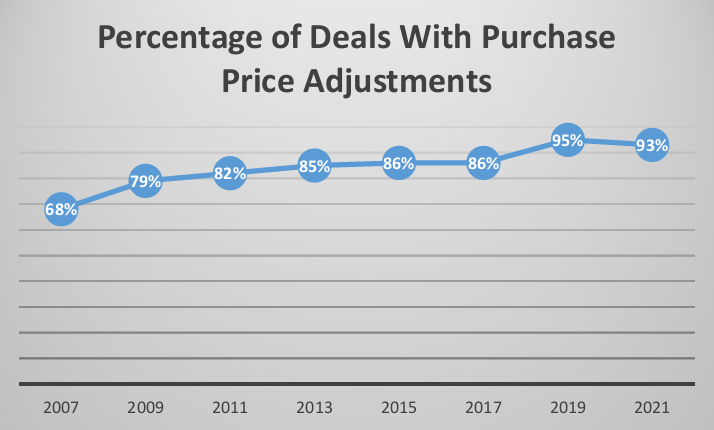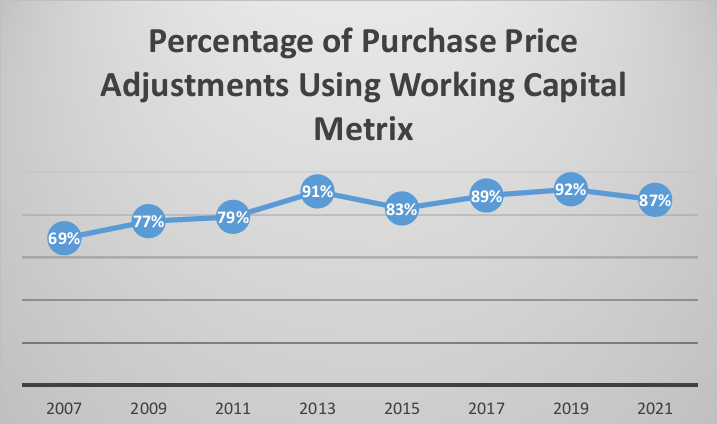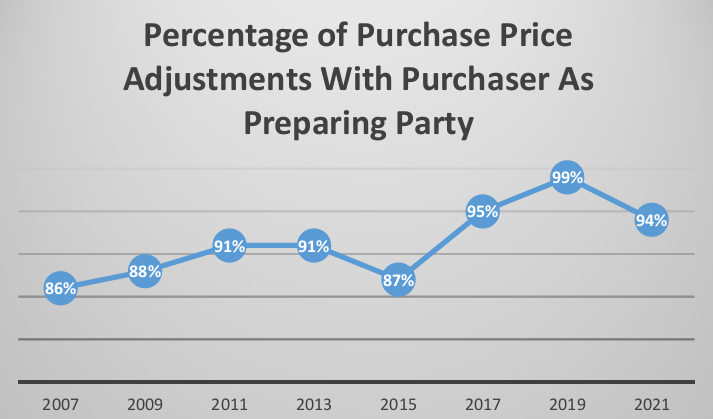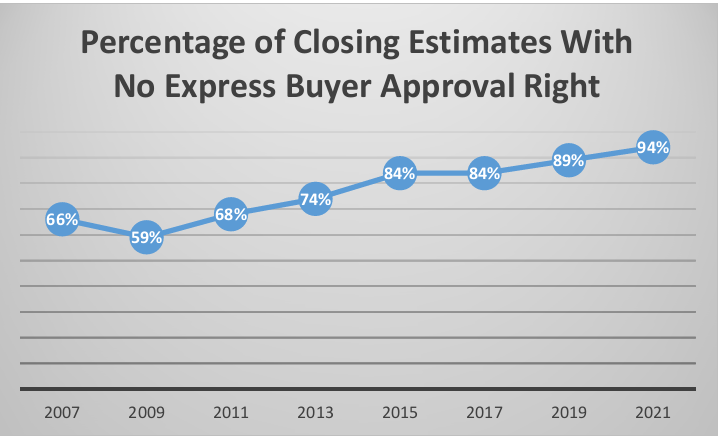Goulston & Storrs M&A attorney Dan Avery is a nationally recognized expert on M&A deal point trends. In partnership with Bloomberg Law, Dan has developed a series of 25 articles looking at these trends, on a topic-by-topic basis, providing practical insight into where these trends are heading, and the relevant implications for M&A deal professionals.
Market Trends: What You Need to Know
Based on the American Bar Association's Private Target Mergers and Acquisitions Deal Points Studies:
- Purchase price adjustments continue to be commonplace in M&A agreements. In the 2021 study, they were included in 93% of reported deals.
- Working capital is the most common purchase price adjustment metric, included in 87% of deals from the 2021 ABA study.
- The buyer now almost always prepares the initial post-closing purchase price adjustment calculation. This was the approach for 94% of reported deals in the 2021 study.
- Increasingly, M&A deals include an estimated purchase price adjustment true-up at closing, as reflected in 82% of reported transactions in the 2021 study.
- Increasingly, there is no express buyer right to approve the estimated adjustment at closing. In the 2021 ABA study, 94% of deals with closing estimates had no such buyer approval right.
Introduction
Purchase price adjustment provisions are designed to reflect changes in the target's financial condition that occur prior to the closing of the transaction. For example, if on January 1, a transaction is valued, or priced, at $10,000,000 when the target has inventory worth $100,000, and if, when the transaction closes, all other financial metrics being equal, the seller delivers the target with $500,000 of inventory, the seller will expect to be paid, often dollar for dollar, for the additional $400,000 of added, measurable value.
Alternatively, if at closing the target's inventory is valued at $50,000, the buyer would expect a $50,000 reduction in the purchase price due to the depleted inventory value. Because purchase price adjustment provisions are intended to put the parties on an equal footing, as of the closing date, these provisions are not normally viewed as benefitting or favoring the buyer or seller. Instead, they are considered neutral as between the parties.
Once the parties to the transaction have agreed upon a purchase price, often subject to the buyer's satisfactory completion of its due diligence or other conditions, the lawyers are often asked to memorialize three aspects regarding the purchase price:
- The particular financial metric to be used for purchase price adjustment purposes.
- The benchmark amount of that metric against which the corresponding closing amount is to be measured.
- The specific procedures pursuant to which the adjustment is to be determined, before and/or after closing.
Common Financial Metrics Used in Purchase Price Adjustments
Purchase price adjustment provisions can be based on any number of financial metrics, though most frequently these provisions are tied to changes in working capital. Working capital is typically determined under generally accepted accounting principles (GAAP) as the excess of the target's current assets cash, inventory, and accounts receivable—over the target's current liabilities—ordinary course payables and other short-term obligations payable within one year. Because working capital is the most common metric used for purchase price adjustments, this article focuses on provisions using working capital as the adjustment metric.
A purchase price adjustment provision using working capital may read:
The Purchase Price shall be adjusted dollar-for-dollar: (a) upward by the amount (if any) by which Working Capital as of the opening of business on the Closing Date shown on the Closing Statement (the “Closing Working Capital”) is greater than Target Working Capital; or (b) downward by the amount (if any) by which Closing Working Capital is less than Target Working Capital.
Establishing the Benchmark Amount
In the example above, the benchmark amount of working capital is referred to as the target working capital, which is often a set amount that the parties agree to during negotiations. However, getting the parties to agree on the benchmark is not always easy. For example, the parties may attempt to determine the benchmark working capital amount as of the date that the transaction was “priced.”
But, this is often easier said than done, as it is not often clear when the buyer priced the transaction or when exactly the parties agreed on the price. Was it when the letter of intent was signed, when the buyer completed its initial financial due diligence, or some other time?
In addition to timing difficulties, in many business sectors, the target's working capital may fluctuate seasonally or otherwise. As a result, the selection of a certain date from which to calculate the benchmark working capital may be far from perfect. Therefore, the parties may seek to determine a “representative” level—i.e., an average working capital calculated across an agreed upon time frame—of working capital as the benchmark to address any seasonal or other fluctuations.
Purchase Price Adjustment Procedures
If the parties agree to use a purchase price adjustment, then the procedures for the adjustment often follow the following parameters:
Timing of Adjustment. Because it takes time to determine, with any meaningful degree of precision, the target's working capital as of the closing date, most purchase price adjustments occur after closing. However, if the parties believe at or prior to closing that the target's working capital is likely to be materially different, whether up or down, than the benchmark, they may agree to a purchase price adjustment calculated at closing based on the parties’ best estimates of the target's closing working capital.
The parties would then complete a second post-closing adjustment using the closing adjustment as a benchmark. For example, if the purchase price is $100 and the original target (benchmark) working capital level is $10, and the parties agree prior to closing that the closing working capital level is likely to be closer to $25, rather than do the entire adjustment post-closing, they may decide to: adjust the purchase price payable at closing to $115 to reflect the likely additional $15 of working capital ($25-$10), and conduct a post-closing adjustment using $25 as the new benchmark for working capital.
Submission of Closing Working Capital Calculation. Following the closing, either the buyer or the seller has a set period of time to submit a calculation of closing working capital to the other party, along with the submitting party's calculation of the resulting adjustment to the purchase price.
Procedures for Disputing a Submitted Calculation. The party receiving the calculation is typically given the opportunity, within a specified timeframe, to dispute the working capital calculation. Most purchase agreements provide that if a dispute is not sent to the submitting party within the specified time frame, the submitting party's calculations are deemed accepted.
Procedures for Handling a Dispute. If there is a dispute, often the purchase agreement requires the parties to first attempt to resolve their disagreements among themselves within a specified time period. Any disputes that cannot be resolved within the specified time period are typically sent to a third party in a non-judicial setting, e.g., a nationally recognized accounting firm or other professional expert with knowledge of the relevant industry. The parties may agree upon and identify the third-party arbitrator in the purchase agreement, or the purchase agreement may set forth the procedures for selecting an arbitrator, or arbitrators, as there may be more than one.
Trends in Purchase Price Adjustment Provisions
Every other year since 2005, the ABA has released its Private Target Mergers and Acquisitions Deal Points Studies. The ABA studies examine purchase agreements of publicly available transactions involving private companies. These transactions range in size but are generally considered as within the “middle market” for M&A transactions; the transaction values of the 123 deals within the 2021 study ranged from $30 to $750 million.
The ABA studies show the following trends:
Purchase Price Adjustments. Purchase price adjustments continue to be commonplace, if not ubiquitous now, in M&A agreements. In the 2021 ABA study, they were included in 93% of reported deals, down just slightly from 95% in 2019.


GRAPHIC—Source: ABA Private Target Mergers and Acquisitions Deal Points Studies
Adjustment Metrics. Working capital is the most common purchase price adjustment metric, included in 87% of deals reported in the 2021 ABA study. With the exception of the 69% reported in the 2007 ABA study, working capital has been used as an adjustment metric in more than 75% of the reported deals in each ABA study since 2007—92% (2019), 89% (2017), 83% (2015), 91% (2013), 79% (2011), and 77% (2009).


GRAPHIC—Source: ABA Private Target Mergers and Acquisitions Deal Points Studies
Preparation of Initial Adjustment Calculation. According to the ABA studies, the buyer now almost always prepares the initial post-closing purchase price adjustment calculation (if one is to be made). This was the approach for 94% of the applicable, reported deals in the 2021 study.


GRAPHIC—Source: ABA Private Target Mergers and Acquisitions Deal Points Studies
Pre-Closing True-Up. Increasingly, private company M&A deals include an estimated purchase price adjustment true-up at closing. The ABA studies show this trend, occurring in 82% of deals in 2021, 97% of deals in 2019, 86% in 2017, 89% in 2015, 88% in 2013, 85% in 2011, 76% in 2009, and 64% in 2007.


GRAPHIC—Source: ABA Private Target Mergers and Acquisitions Deal Points Studies
No Buyer Right to Approve Estimated Adjustment. Increasingly, there is no express buyer right to approve the closing estimated adjustment. In the 2021 ABA study, 94% of the deals with closing estimates had no such express right, compared with 89%, 84%, 84%, 74%, 68%, 59%, and 66% in the previous seven studies.


GRAPHIC—Source: ABA Private Target Mergers and Acquisitions Deal Points Studies
Conclusion
Many provisions in an M&A purchase agreement reflect an allocation of risk between the seller and buyer, including provisions relating to financial matters, compliance with laws, labor and employment, employee benefits, contracts, operations in the ordinary course of business, title, and sufficiency of operating assets.
The buyer and seller may have different views on their respective risk tolerance (for example, the seller of a service company with no owned real estate and no manufacturing may have a relatively relaxed view about allocation of environmental risk), and, as a result, some of these matters may be negotiated in favor of one party or the other.
However, purchase price adjustments are considered to be neutral between the parties. These provisions are linked, often dollar-for-dollar, to the purchase price, in amounts which should be readily calculable, and determinable shortly after closing. The adjustment provisions, while usually quite straightforward, are nonetheless important to ensure that the parties receive the economic results they bargained for.
Click here for a pdf of the article.
Reproduced with permission from Bloomberg Law. Copyright ©️2022 by The Bureau of National Affairs, Inc. (800-372-1033) http://www.bloomberglaw.com.

/Passle/630ddfd8f636e917dcf6e4ce/SearchServiceImages/2024-04-22-16-48-04-221-662694c48171a252db3820bd.jpg)
/Passle/630ddfd8f636e917dcf6e4ce/SearchServiceImages/2024-04-22-15-12-36-997-66267e64d100dba38ac045e7.jpg)
/Passle/630ddfd8f636e917dcf6e4ce/MediaLibrary/Images/2024-04-22-13-15-13-552-662662e18171a252db378c86.png)
/Passle/630ddfd8f636e917dcf6e4ce/MediaLibrary/Images/2024-04-10-02-23-24-827-6615f81c7f643c6b40a522fc.png)